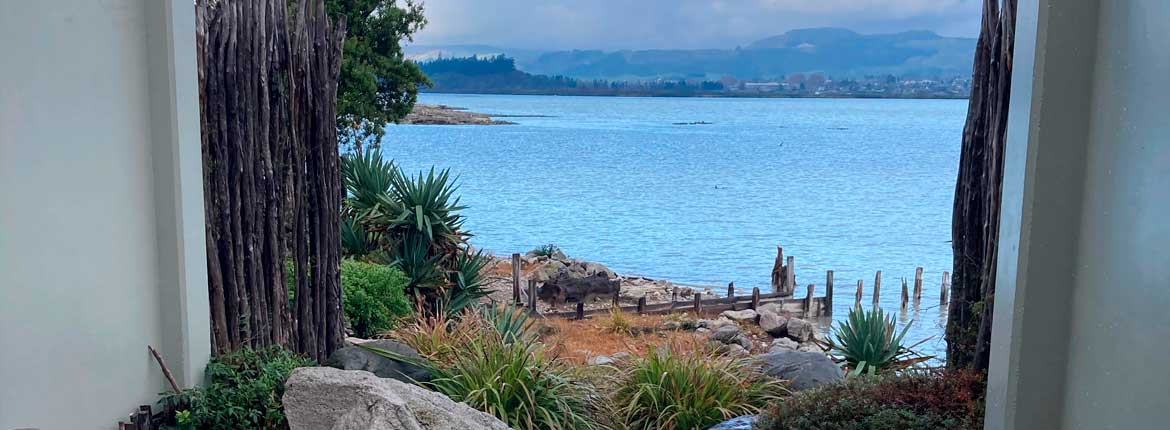
Taking the waters of Rotorua
I believe that it's far more effective to focus on increasing your income through a combination of mindset and business techniques, than on cutting costs.
Indulgence and history attract Josie Steenhart to Rotorua.
There are surely few more captivating, surprising and otherworldly strolls to take than those on the paths skirting Lake Rotorua.
At any given point you’re liable to see steam threading from nearly invisible fissures in the earth or wafting in ethereal mists from the surface of the lake itself, blurping puddles of hot bubbling mud, strange mineral deposits in almost fluorescent shades and pīwakawaka flitting unfazed through the mānuka.
Then there’s that signature sulphur scent. But what makes an invigorating Rotorua lake jaunt even more special is that you can end up sinking with a happy sigh into a perfectly hot mineral pool overlooking that stunning, steaming body of water.
The place to go for a soak now is Polynesian Spa. Built in the early 1970s on the site of former bath houses, it has 28 hot mineral pools sourced from two natural springs. The gently acidic Priest Spring waters relieve tired muscles, aches and pains while the alkaline Rachel Spring waters nourish the skin.
While the building itself doesn’t have the charms of its iconic neighbours – the Tudor-style Bath House (now the Rotorua Museum, currently closed for earthquake assessment) and the Art Deco Blue Baths, built in 1908 and 1933 respectively – it makes up for it in other ways.
There’s a pool for every taste: private oases for two, springs in a spectrum of temperatures from ice-cold plunge-pool to skin-tingling- ‘hot’-hot, a full-sized number for swimming laps and supervised family spots for sliding, splashing and delighted screaming.
No ‘taking of the cure’ would be complete without indulging in a therapeutic treatment and, while things have come a long way in that regard, in the last century (having peered at old photos and read historic descriptions that seem more akin to torture devices), the onsite Retreat Day Spa offers several specialties that visitors to the area more than 100 years ago may have enjoyed.
Hydrotherapy spa treatment Aix, based on a system used at the French spa of Aix-les-Bains, was introduced to Rotorua in 1903, and involves a massage under jets of thermal water. Then there’s the mud. Not ordinary mud, of course, but volcanic thermal mud, which feels like pure heaven going on, and promises beautifully soft, smooth, balanced skin once removed. At the Polynesian Spa you can have mud facials, mud scrubs, mud massages or mud body wraps, which complement the more familiar and contemporary spa offerings.
While we might have shared a desire for good health and relaxation with our Victorian forebears, they didn’t suffer from any of our distinctly contemporary afflictions such as social media addiction, technology dependence or ‘busyness’ syndrome. To counter this, Polynesian Spa hosts Mindful Moments retreats which pair guided yoga, mindfulness, meditation and wellness activities with its spa and pool offerings, for the ultimate contemporary way to refresh, rejuvenate and really slowwww dowwwwn.
Before or after you’ve soaked and spa’ed until utterly sated, take a meander through the immaculately-manicured Government Gardens for a palpable sense of the area’s rich history.
On the edge of the gardens sit several of the city’s most fabulous old buildings, including the decorative Old Post Office Clock Tower and the elegant Victorian Prince’s Gate Hotel, where you can enjoy a coffee in the sun, sample the award-winning fare (which draws on ingredients like horopito and kawakawa and includes hāngī-style roast meats) or stay the night.
As with all good things in Rotorua, the hotel has an intriguing history, having first been located further north in Waihī from 1897 before being entirely dismantled, transported by horse-drawn wagon and train, and rebuilt, “nail by nail and board by board,” in its current location in 1917.
As both a lover of history and of indulgent ways to relax, staying at the Prince’s Gate just minutes’ walk from the lake and all it offers was the icing on the cake of a weekend that fused pure unwinding, relaxing in nature and experiencing Rotorua’s unique heritage.
Reported by Josie Steenhart for our AA Directions Spring 2020 issue
